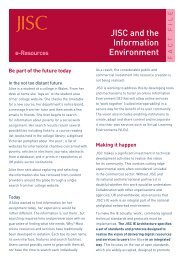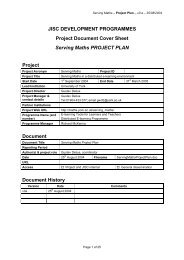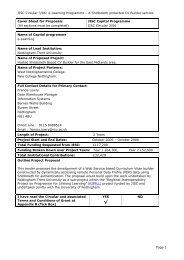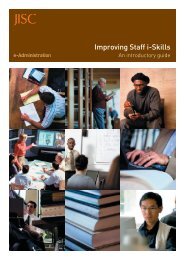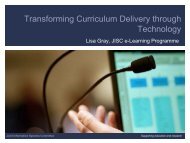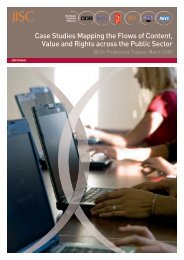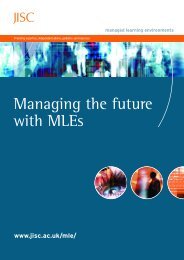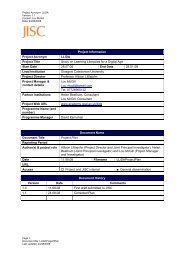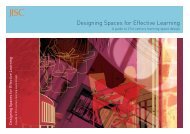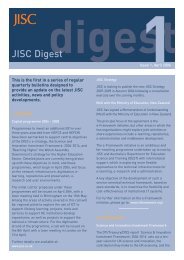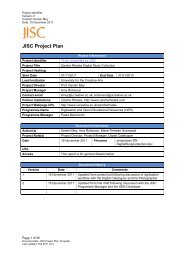Deterring, Detecting and Deailing with Student Plagiarism - Jisc
Deterring, Detecting and Deailing with Student Plagiarism - Jisc
Deterring, Detecting and Deailing with Student Plagiarism - Jisc
Create successful ePaper yourself
Turn your PDF publications into a flip-book with our unique Google optimized e-Paper software.
<strong>Deterring</strong>, <strong>Detecting</strong> <strong>and</strong><br />
Dealing <strong>with</strong> <strong>Student</strong> <strong>Plagiarism</strong><br />
Briefing Paper January 2005<br />
There is evidence to support widely expressed concerns<br />
that student plagiarism in the UK is common <strong>and</strong> is<br />
probably becoming more so (Park, 2003).<br />
Most institutions that decide to reconsider <strong>and</strong> update their<br />
approaches to student plagiarism will have to develop<br />
their own approach to detection, <strong>and</strong> implement homegrown<br />
procedures to make policies operational. Some have<br />
already done so. This briefing paper seeks to support the<br />
efforts of institutions wishing to reconsider the policies <strong>and</strong><br />
any procedures they currently have.<br />
What has caused the rise in<br />
deliberate cheating?<br />
Although students who misunderst<strong>and</strong> or misuse academic<br />
conventions <strong>and</strong> attribution rules form the majority of<br />
plagiarists, those who do so deliberately account for<br />
the majority of concern about plagiarism. <strong>Student</strong>s who<br />
deliberately cheat or engage in fraudulent behaviour are<br />
characterised as threatening the values <strong>and</strong> beliefs that<br />
underpin academic work, angering <strong>and</strong> discouraging other<br />
students who do not use such tactics, devaluing the integrity<br />
of UK awards <strong>and</strong> qualifications, <strong>and</strong> distorting the efforts of<br />
lecturers who wish to teach rather than police others’ actions.<br />
A decision to plagiarise may be associated <strong>with</strong> increasing<br />
pressures on students arising from, for example,<br />
undertaking paid work, heavier coursework load, or lack of<br />
personal organisation skills (Bannister <strong>and</strong> Ashworth, 1998).<br />
When stresses rise, students see plagiarism as a reasonable<br />
<strong>and</strong> reasonably risk-free way out of difficulties.<br />
A minority of students do deliberately plagiarise. We can<br />
only guess as to the frequency of behaviours such as paying<br />
ghost writers, wholesale downloading of coursework, or<br />
copying from other students although the increasing use of<br />
electronic detection tools such as Turnitin UK software in the<br />
UK is building an evidence base.<br />
Many studies show that the bulk of plagiarism can be<br />
attributed to students who do not underst<strong>and</strong> academic<br />
requirements. <strong>Plagiarism</strong> may be more common in some<br />
teaching methodologies or programme structures. It is often<br />
discussed in connection <strong>with</strong> ‘top-up’ final year programmes<br />
<strong>with</strong> high numbers of international students who do the first<br />
two years in their home country then finish the degree in the<br />
UK, often submitting a dissertation after eight months of UK<br />
study. Many academics do not think this is sufficient time<br />
for students to develop the required skills. Others worry it<br />
is more frequent in distance-learning programmes where<br />
authorship of coursework cannot be easily authenticated. It<br />
may be more common in very large classes. If these students<br />
enter programmes where the ‘rules of the game’ are unclear,<br />
they might continue to use tried <strong>and</strong> tested approaches <strong>and</strong><br />
thereby, inadvertently, plagiarise. The number of students<br />
falling into this category will grow as student cohorts become<br />
more diverse due to widening participation, increasing<br />
numbers of international students <strong>and</strong> greater use of different<br />
teaching modes (eg distance learning, work-based learning).<br />
Encouraging ownership <strong>and</strong> helping to establish<br />
the underlying cultures <strong>and</strong> beliefs that shape the<br />
framework for dealing <strong>with</strong> student plagiarism must<br />
be lead from the top <strong>with</strong> commitment from the Vice<br />
Chancellor or Head of College. The emphasis should be<br />
very firmly upon teaching <strong>and</strong> valuing students’ learning<br />
rather than on detecting <strong>and</strong> dealing <strong>with</strong> offenders.<br />
Effective institutional approaches to<br />
deterring student plagiarism<br />
A holistic, coordinated, institution-wide approach to<br />
plagiarism is a more effective way to proceed <strong>with</strong><br />
an institutional plagiarism policy, as any single focus<br />
interventions (eg encouraging better detection, making<br />
induction compulsory etc) will not have a significant effect on<br />
the complex issue of student plagiarism.<br />
A national initiative for dealing <strong>with</strong> student plagiarism<br />
was established in 2001 by the Joint Information Systems<br />
Committee (JISC) which launched <strong>and</strong> funded the <strong>Plagiarism</strong><br />
Advisory Service, designed to offer advice <strong>and</strong> guidance <strong>and</strong><br />
to host the UK implementation of a US-registered electronic<br />
detection service called Turnitin. Both aspects of the Service<br />
have subsequently contributed to institutional approaches<br />
to dealing <strong>with</strong> plagiarism by providing a central focus<br />
for institutional support. The service provides: a website;
<strong>Deterring</strong>, <strong>Detecting</strong> <strong>and</strong><br />
Dealing <strong>with</strong> <strong>Student</strong> <strong>Plagiarism</strong><br />
workshops <strong>and</strong> conferences; it undertakes research; has<br />
created an audit tool <strong>and</strong> provides access to the detection<br />
software ‘Turnitin UK’ for all higher education (HE) <strong>and</strong><br />
further education (FE) institutions in the UK.<br />
In 2002, CAVAL, a university library consortium in Australia,<br />
used Turnitin software to screen 1,770 pieces of student work<br />
from five HE institutions over a range of disciplines <strong>and</strong> found<br />
that 8.8% contained more than 25% of unattributed web-based<br />
material. The same study found two instances (out of 1,770)<br />
of student work containing more than 75% of unattributed<br />
material, most of it from the web though some may have been<br />
identified from the Turnitin database of student material.<br />
Placing the emphasis on deterrence<br />
<strong>and</strong> assessment<br />
<strong>Deterring</strong> plagiarism will always be more effective than<br />
detecting it once it occurs <strong>and</strong> significantly less timeconsuming<br />
than pursuing <strong>and</strong> punishing offenders. ‘Catch<br />
<strong>and</strong> punish’ approaches are self-defeating in that they<br />
absorb huge amounts of staff time (Carroll, 2002b), do<br />
not lessen the overall incidence of plagiarism, <strong>and</strong> deflect<br />
students from a focus on learning to one devoted to not<br />
breaking rules or not getting caught (Cole <strong>and</strong> Kiss, 2000).<br />
Where Turnitin UK software has been adopted, institutions<br />
have used a variety of approaches. Some are screening large<br />
cohorts; others do so r<strong>and</strong>omly. Some offer access to students<br />
as a tool for learning how to use referencing <strong>and</strong> acceptable<br />
paraphrasing. Whatever the approach all institutions ensure<br />
students underst<strong>and</strong> the inspection process.<br />
Senior managers should take a view about how, where<br />
<strong>and</strong> by whom plagiarism will be detected <strong>and</strong> what should<br />
happen once it is identified.<br />
Creating specialist officers for<br />
dealing <strong>with</strong> plagiarism<br />
An increasing number of institutions have designated<br />
specialist officers (or, in the case of Sheffield Hallam<br />
University, a panel of specialist officers) located <strong>with</strong>in<br />
the school or department, who deal <strong>with</strong> all cases of<br />
plagiarism. Under this system, markers must continue to<br />
detect unacceptable behaviour but then pass the case to the<br />
specialist who decides whether plagiarism is demonstrated<br />
<strong>and</strong> allocates a punishment from a limited range of options.<br />
Oxford Brookes University, where the system has been<br />
in place for five years, has 14 Academic Conduct Officers<br />
located in the eight academic schools who interview the<br />
student, review the case presented by the person who<br />
detected it <strong>with</strong> the student at an interview, decide whether<br />
the evidence warrants taking action <strong>and</strong>, if so, select the<br />
appropriate level of action.<br />
Both intentional <strong>and</strong> unintentional plagiarism are<br />
unacceptable though the approaches to tackling them <strong>and</strong><br />
the consequences for the student are necessarily different.<br />
Tackling plagiarism requires action at the national level,<br />
at the level of the institution as a whole, at the level of<br />
the student’s programme of study, <strong>and</strong> at the level of the<br />
individual lecturer or member of staff responsible for<br />
decisions affecting the student. Action can start at any point<br />
in this interconnected network of activity, however it will<br />
only be fully effective if all aspects are addressed. The key<br />
to a holistic approach lies in an underst<strong>and</strong>ing of the issues<br />
of plagiarism <strong>and</strong> a shared sense of responsibility for the<br />
problem of student plagiarism <strong>and</strong> its solution between<br />
all levels. A major success factor will be the commitment,<br />
energy <strong>and</strong> focus of the senior managers of the institution.<br />
Actions <strong>and</strong> Resources<br />
■ Establish the culture <strong>and</strong> overall values, placing academic<br />
issues at the centre of the discussions <strong>and</strong> any changes<br />
■ Appoint a named person responsible for ensuring the<br />
institution is dealing effectively <strong>with</strong> student plagiarism<br />
■ Ensure policies <strong>and</strong> procedures are appropriate to the<br />
current situation<br />
■ Require systems for keeping records of all incidences <strong>and</strong><br />
what action has been taken; identify the person or people<br />
responsible for monitoring <strong>and</strong> reviewing data; identify how<br />
<strong>and</strong> where the resulting information will be discussed<br />
For more advice about plagiarism <strong>and</strong> information about the<br />
electronic detection service contact:<br />
www.jiscpas.ac.uk<br />
This paper was taken from a report produced by Jude Carroll<br />
on behalf of JISC. The full report <strong>with</strong> full references can be<br />
found at:<br />
www.jisc.ac.uk/publications<br />
■ Take steps to improve detection rates, including access to<br />
electronic detection tools<br />
■ Create communication systems that allow consultation,<br />
discussion <strong>and</strong> dissemination of information




